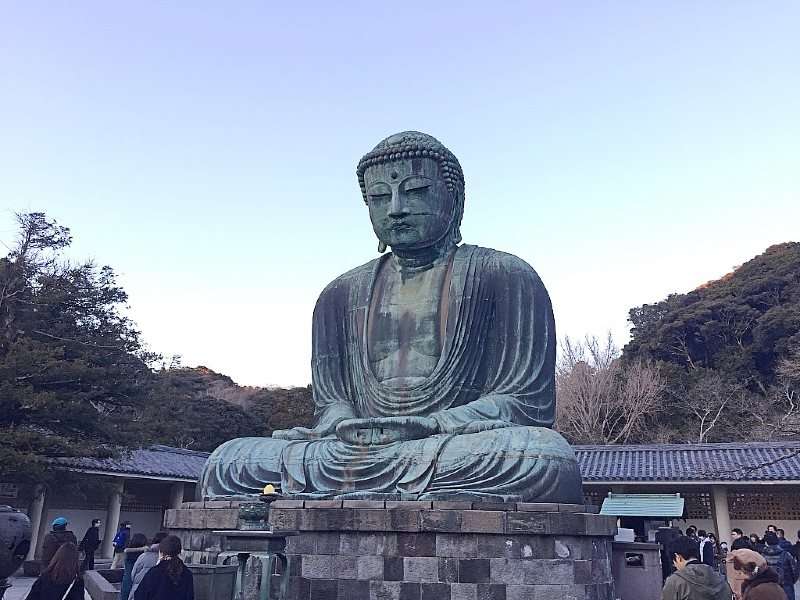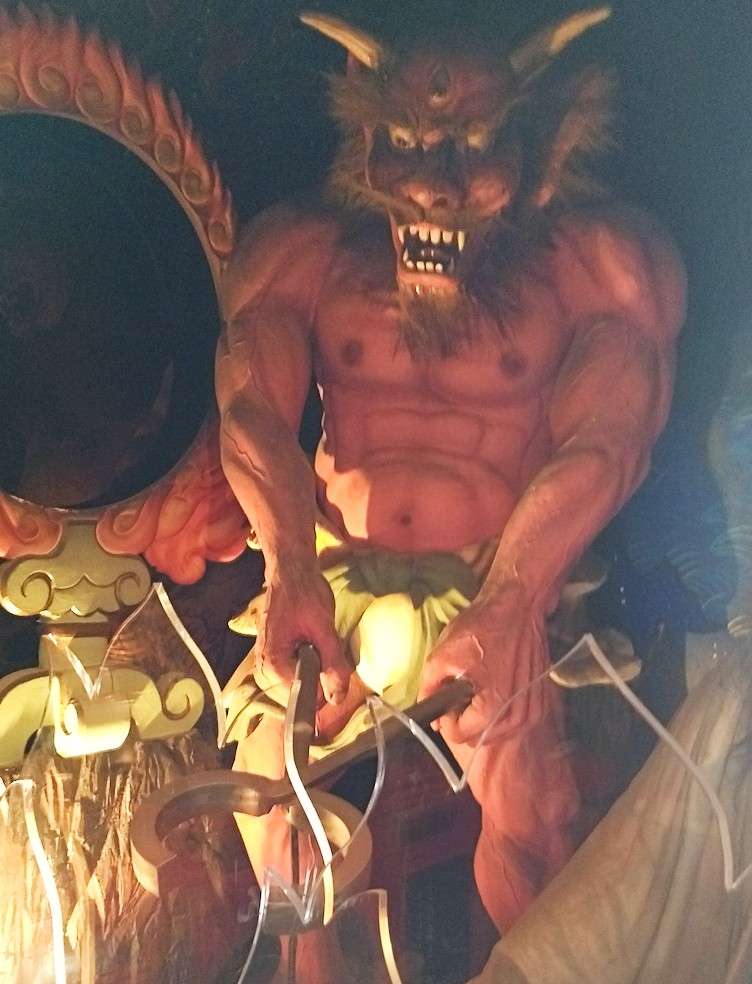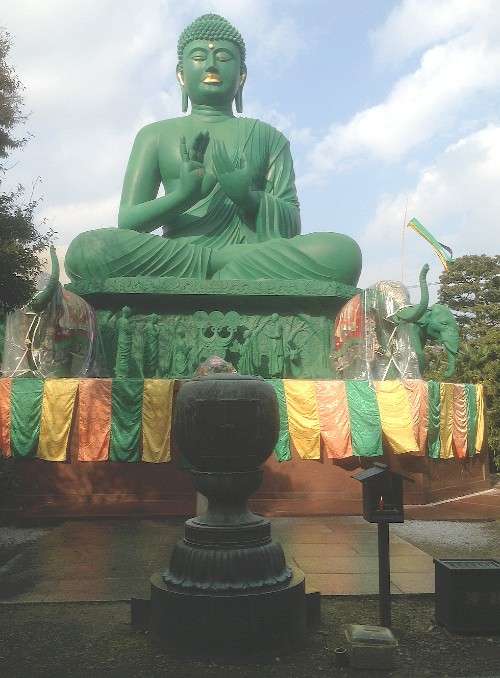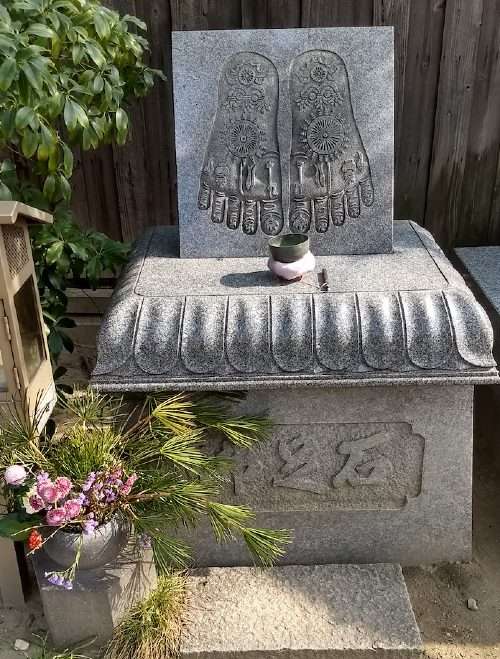
Japanese Zen Buddhism is often associated with a certain set of performance arts that are frequently referred to as “Zen arts,” such as the “the way of tea” (Jap: sadō)—also called the “water of tea” (Jap: cha no yu)—martial arts (Jap: budō), “flower arrangement” (Jap: ikebana), “the way of the scent” (Jap: kōdō), garden landscaping called, literally, “dry mountains and waters” (Jap: karesansui, and calligraphy (Jap: shodō). While most of them were associated with Buddhist temples—at least, during the history of Buddhism in Japan—the last one is still used in the practice of copying sūtras (Jap: shakyō) in monastic and lay communities. Quite a few books have been written about the connection between these art forms and Buddhist practice, and one of my previous essays for Buddhistdoor Global discussed the Japanese tea ceremony.* In this essay, I would like to discuss art used in Buddhist rituals and for Buddhist edification.
From the moment Buddhism arrived in Japan in the Asuka period (538 –710), its proponents used art to enhance worship and to propagate its teaching. In 604, Prince Shōtoku declared Buddhism the state religion of Japan in his 17-article constitution. Subsequently, Buddhism was used in the service of the government to protect the state. It also had to be promulgated to a people that was not familiar with Buddhism. For the purposes of propagation, picture scrolls (Jap: emaki) were used to illustrate episodes from the scriptures and events in the history of Buddhism. These scrolls present depictions of Prince Shōtoku, sometimes identified as the father of Japanese Buddhism, visions of the Pure Land or Amida Buddha welcoming deceased practitioners, stories about temple life, and ghost stories. In premodern times, the practice of explaining the Dharma with pictures (Jap: etoki) was extremely popular, but today it has been supplanted by mangas and picture books.
Similarly, paintings in temples often tell stories central to Buddhist institutions and mythology. For me, one of the most impressive is a gigantic scroll painting in Enryaku-ji, now exhibited in its museum complex, on Mount Hiei that narrates the history of Buddhism from Shakyamuni’s first sermon via its spread across South and Central Asia to Xi’an and, ultimately, Mount Tiantai in today’s Zhejiang Province. In the middle of this gigantic picture, one can detect Xuanzang with his iconic backpack making his way through the desert on his arduous journey to India to collect Buddhist scriptures from India. The art in some temples such as Gokuraku-ji, temple No. 2 on the Shikoku pilgrimage, include depictions of hell in rather graphic forms and/or large-scale depictions of the six realms of saṃsāra. Others, such as Senkō-ji, temple No. 7 of the Thirteen Buddhist Sites in Ōsaka even feature a so-called “hell-hall” (Jap: jigokudō) in which one can have a taste of the worst of all rebirths. On the other hand, some temples, such as the famous Tōdai-ji in Nara, have been built as three-dimensional depictions of the Pure Land and the Garan on Mount Kōya as a three-dimensional mandala.**

Photo by the author
It is, of course, impossible to do justice to this wealth of art in a single essay, so I would like to focus on a few Buddha statues. On one of my many travels to Japan, I ran across Shinnosuke Saijō’s The World of Buddha-Statues (Butsuzō no sekai). This book not only provides an overview and explanation of the symbolism of the Buddha statues most commonly used in Japan, but also offers an overarching framework to interpret the meaning behind their symbolism. Using Kūkai’s esoteric Buddhism (Jap: mikkyō), Saijō maps the wealth of Buddha statues in Japanese temples onto the Buddhist theories of “three worlds” (Skt: traidhatūka): the world of desire, the world of form, and the world of the formless, and “ten worlds” (Jap: jikkai): the six realms of saṃsāra, and the four realms of awakening, according to Mahāyāna Buddhism. Saijō identifies five different categories of statue, or forms of the cosmic Sun Buddha Mahāvairocana: 1) buddhas, 2) bodhisattvas, 3) wisdom kings (Jap: myō’ō), 4) heavenly beings, and 5) others (Jap: sono ta).
Buddhas have awakened their buddhahood. Therefore, they are frequently depicted seated on a lotus flower and surrounded by a halo. Buddhas are portrayed with a distinctive curly hair, a frugal gown, and, with the exception of the Medicine Buddha, empty hands, and very specific mudrās. The most frequently depicted in Japan are Mahāvairocana Buddha, Amida Buddha, Shakyamuni Buddha, and the Medicine Buddha (Jap: Yakushi nyorai). Mahāvairocana embodies the cosmos and is often depicted with his hands forming the vajra mudrā, in which the right hand grasps the raised index finger of the left hand. This mudrā symbolizes supernatural power. The Medicine Buddha—and on rare occasions Mahāvairocana—holds a medicine jar in his left hand.

Tōgan-ji in Nagoya. Photo by the author

Senkōji in Ōsaka. Photo by the author
Shakymuni Buddha is portrayed in four basic forms: as teacher either standing upright or in a seated position, in seated meditation, and lastly in the horizontal position symbolizing his entry into parinirvāṇa. As a teacher in the standing position, he holds his right hand up forming the fearlessness mudrā (Jap: semuiin), while his left hand is points downward forming the welcome mudrā (Jap: yogan’in). As a teacher in the seated position, both of his hands form the turning-the-Dharma-wheel mudrā (Jap: tenbōrin’in). In the meditative position, his hands form either the meditation mudrā (Jap: jōin), which is typically used for seated meditation (Jap: zazen) in Japan, or the defeating-Māra mudrā (Jap: gōmain). The final posture depicts the Buddha holding his left hand horizontally in front of his belly while the right hand touches the ground. This is the posture Buddha is said to have embraced at the time he entered nirvāṇa. On the feet of the lying Buddha, whose head frequently rests on a Lotus blossom, the Dharma wheel (Jap: hōrin) is engraved. Amida Buddha is mostly depicted as a teacher, either in a standing or a seated position, holding his hands in one of three variations, each depicting either the meditation mudrā or the teaching mudrā (Jap: raigōin).***
The statues of the bodhisattvas express wisdom and compassion. Bodhisattvas are mostly depicted sitting or standing on lotus blossoms and are endowed with numerous symbols and artifacts. For example, the 11-headed Kannon Bodhisattva or the thousand-armed Kannon Bodhisattva are equipped to see and rescue all sentient beings in and from their suffering. Jizō (Skt: Kṣitigarbha) is frequently portrayed as an itinerant as he protects travelers as well as children and rescues the dead from the underworld. The wisdom kings embody various forms of Mahāvairocana Buddha, protect the Dharma, and liberate sentient beings. The most popular of the wisdom kings in Japanese Buddhism, Fudō Myō’ō (Skt: Acala), is portrayed sitting on a rock in the middle of fire, the fire of passions, his horrifying exterior is supposed to scare the demons. He waves a sword to cut off illusions and he carries a rope to recue sentient beings. The heavenly beings protect the Dharma and temples. Among them one can find deities imported from Daoism and Hinduism. The “others” are made out of historical figures, such as Kūkai and Shintō deities. Such is the rich world of buddhist statues in Japan.
Together, these pictures and statues express the teachings of Buddhism and the vitality of its adherents, who continuously explore new ways to teach, to worship, and to practice.
* Drinking Tea – Meeting the Buddha (Buddhistdoor Global)
** Walking with Kukai – Becoming a Buddha (Buddhistdoor Global)
*** Some of these mudras can be found online at Onmark Productions.
References
Saijō, Shinnosuke. 1996. Butsuzō no sekai. Tokyo: Ōesu Shuppansha.












